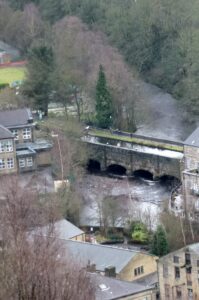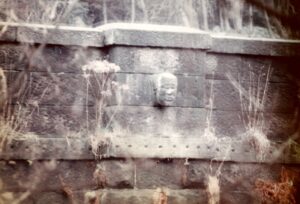The first point noticed about the Hebden Bridge Zodiac is that it is ‘upside-down’; which it isn’t of course, except insofar as maps are oriented with N at the top. More accurately, the figures all present themselves to be viewed from a northerly perspective, rather than, as in other zodiacs, revolving around a central point. Why this should be I have no idea and no suggestions. But it means that a ‘true centre’ will be elusive, and the best we might hope for is a symbolic focus somewhere in a general vicinity.
We might take as a guide a prominent suggestion of an axis. For this, the Crow, appropriately, can be a guide. From its head on Crow Hill, its gaze, the line of its beak, can be followed almost straight to Mount Skip, below which until the 1990s was a popular inn of that name, and down along Virgo’s back on Wadsworth Banks to the centre of Hebden Bridge. Or we might look towards Stoodley Pike, and north of the monument follow the line of Pinnacle Lane between Pisces and Aries, to a track dropping down the hillside into Hebden Bridge. The line of the imagined arrow from Sagittarius’ bow, and the stare from Gemini’s helmeted head focus likewise on the town, reinforced by the raptor gaze of the Libra hawk and the Aquarian eagle.

Where they meet is in the vivinity of Black Pit, where the Hebden Water joins the River Calder, generating a powerful whirlpool at times of spate. Here, straddling a point on the river once considered its most hazardous section, its strong currents conducive to drownings, the Rochdale Canal crosses the Calder on an aqueduct built in 1798. To counter the volatile hazards of both the river and the uncertainties of aqueduct construction, on the middle pier, overlooking the waterfall, they placed a carved ‘archaic head’,[1] invisible to all passers-by, i.e. it wasn’t put there for a human audience but for the river, perhaps ‘the spirit of dark waters’ as the 1970s government information film dreamed it.
Perhaps we may take this mysterious figure, lurking barely visible at such a liminal spot, as our symbolic centre.

- See John Billingsley, A Stony Gaze, Capall Bann 1988